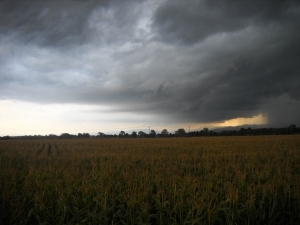Science experiments are perfect for kids because it gets them involved in their learning. It gives them a sense of responsibility and accomplishment that they just don’t get from studying words in a textbook. Weather is a fascinating subject within a science book and lends itself to many hands on lessons. Creating a rain gauge is a good one.
Gather together the following items:
- Large glass jar
- Plastic ruler
- Tape
- Area outdoors away from buildings
- Paper and a pencil
Follow the steps below to create your rain gauge:
Step 1: Find a spot outdoors that is far away from any buildings or tall trees. The reason for this is that the buildings or trees can provide shade for your rain gauge and protect it from getting all the rain. You don’t want to protect it from getting all the rain because your objective is to measure the rainfall.
Step 2: Put your ruler inside of your glass jar with the 1 inch mark facing the bottom of the jar. Have the numbers increase as they come out of the jar. Tape your ruler in place with a strong tape, or a tape that is waterproof. Scotch tape is likely to come loose after a few minutes of rain.
Step 3: Leave your jar outdoors. Some kids wait to place their jars out until it rains, but then they go off to the store with their parents and it starts raining and they missed out on a chance to measure the rain. It is better to place the jar outside and leave it there until after you have experienced a rainfall.
Step 4: Bring your rain gauge in the house. After the rain has finished falling, go grab your rain gauge and bring it inside. What measurement did the rain reach on your ruler? Look at your ruler and measure the water line to the nearest tenth of an inch.
Step 5: Keep track of your findings on a piece of paper. Write the date and time of the rainfall. If you know how long it rained, record that information too. Have students keep a log book of all the times the rain fell in a particular month. Have them take a look at the days that it rained the most and for how long did the rain fall on those days? Have them take a look at the days they only collected small amounts of rain and compare it to how long it rained that day.
Tips: Explain that some rainfalls are harder than others and don’t need to be as long to collect as much water. If you are a homeschooling parent you could collect the rain for several months to a year and compare which months experienced the most rain and which ones experienced the least. There is a reason the phrase “April showers bring May flowers” was created.



